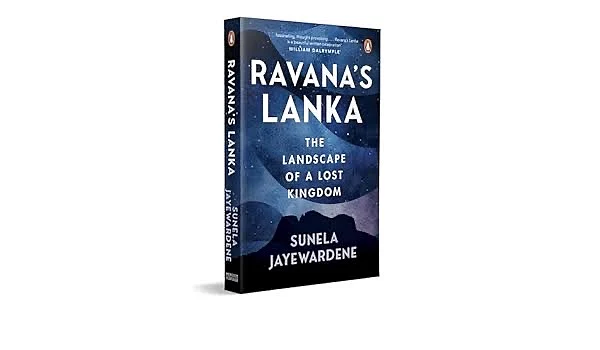‘Ravana’s Lanka: The Landscape Of A Lost Kingdom’ Review: An Intriguing Mix Of The Myth And The Real
Posted on August 31st, 2024
Anjana Basu Courtesy Outlook India
With ‘Ravana’s Lanka,’ Sunela Jayewardene transforms the mythical past of Sri Lanka into a tangible, vivid exploration of history and legend.

Ravana’s Lanka: The landscape of a lost kingdom Photo: Penguin Vintage
Book – Ravana’s Lanka: The landscape of a lost kingdom
Author – Sunela Jayewardene
Publisher – Penguin Vintage
INR 499
Sunela Jayewardene, celebrated as Sri Lanka’s foremost environmental architect, embarked on a journey through the heart of her homeland. She immersed herself in the narratives from the oral traditions, delving into Sri Lanka’s folklore and navigating the intricate web of race and religion that was woven over time. With these threads, she meticulously wove together a narrative of a long-forgotten landscape, the second in her Lanka series.
The tale of the kingdom once ruled by Ravana lies draped over the island consigned to mythology through the pages of the Ramayana yet the contours of the ancient land are still to be found lingering in the terrain which Jayawardene unearthed with the help of archaeologist friends. It is the mix of the myth and the real that makes Ravana’s Lanka so intriguing to those accustomed to a ten-headed demon killed by a magic bow.
Jaywardene’s book begins on a very down to earth note with the geological shifts that resulted in the creation of Lanka and the different migrant peoples that came with the shifts, hunter gatherers and the like. There are tales of the mask makers of Sinhala who were descended from the Nagas, another early dynasty and who still exist to this day, creating masks as symbols of protest. Jayawardene also traces an ecologically sensitive artistic super civilisation that built spas which she is certain Conde Nast would have raved over these days.
King Ravana of Lanka, demonised in the annals of history, had his reign and that of his powerful ancestors, the Mayuranga, obscured and veiled in myth. Legend has it that their kingdom once stretched far beyond Lanka’s shores, conquering lands across the seas—a vast empire the likes of which the island would never see again. Jayewardene takes the narrative beyond the Ramayana to the Yaksas and Rakusas who ruled Lanka until they were conquered by the Indian Buddhist Prince Vijaya with the help of a treacherous Yaksa princess. Vijaya brought Mahayana Buddhism to Lanka and this was apparently the first time Buddhism came to the island, a fact that Jayawardene debunks through archaeological evidence.
Jayewardene puts her architectural skills to archaeological use as she tracks Ravana’s history down various mountain trails with the threats of maneating leopards and marauding elephants to be tackled. While Ram gets not much mention she points out an inscription in a cave by Ravana’s daughter as proof that the king of the Mayurangas existed. She also tells the story of his banishing his baby daughter to King Janak’s fields so that she would not destroy Lanka which like all such predictions came true since he later heard that she was unhappy in her forest hut and kidnapped her. However again, she is unsure which story to follow in the end since the fact that Ravana never touched Sita was apparent and the fact that he would kidnap a woman for lust and then let her be seems unlikely.
Ravana has never shone in the Ramayana context – a dark demon according to the way the Aryans saw the original inhabitants of Lanka – though the same was true for the Indian subcontinent too. However, he created the first musical instrument to sing the first raga of praise to Lord Shiva whose devotee he was. She also mentions the aircraft invention, the Pushpak Rath merging magic and history. Ravana also apparently visited the Buddha after he materialised on earth. Though Theraveda Buddhism was in Lanka before Mahayana Buddhism and Ravana’s brother Kuber, whom some called the god of wealth, was shown as the Laughing Buddha, a form that still exists across South East Asia – this fluidity of eras makes the Ravana Buddha encounter feasible.
The history that she narrates veers between myth and reality crossing the lines between the two on occasion. This is her second book on the past of Lanka and the vast gap that exists between documented history and oral tradition. One might say that Ram’s character is shadowy – she locates him between the coming of the Buddha and Prince Vijaya. Armed with a nuclear astra, his bow, guided by Ravana’s treacherous younger brother, he shoots and kills Ravana in the heart of his palace in the Dumbara Kanduvetiya or Mist Laden Mountains, from an incredible distance away. Jayawardene’s focus remains Ravana, the once and future king whose role was transformed by the conquerors who overran the kingdom.